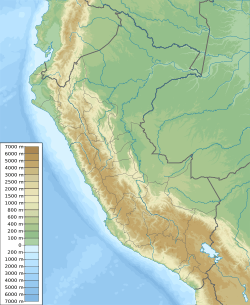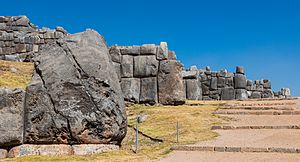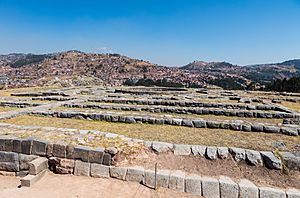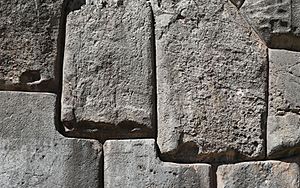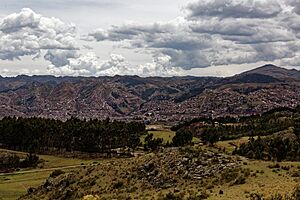Sacsayhuamán facts for kids
|
Saksay waman
|
|
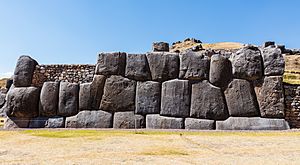
A section of the wall of Sacsayhuamán
|
|
| Location | Cusco, Cusco Region, Peru |
|---|---|
| Coordinates | 13°30′28″S 71°58′56″W / 13.50778°S 71.98222°W |
| Type | Fortification |
| Part of | Cusco |
| History | |
| Cultures | Inca Empire |
| UNESCO World Heritage Site | |
| Part of | City of Cuzco |
| Criteria | Cultural: iii, iv |
| Inscription | 1983 (7th Session) |
| Area | Latin America and the Caribbean |
Sacsayhuamán (pronounced SACK-sy-wuh-mun) is an amazing ancient fortress. It was built by the Incas in Peru. You can find it just outside the city of Cusco. The name Sacsayhuamán comes from the Quechua language. It means "fortress of the royal falcon or hawk."
This incredible place sits high up, about 3,701 meters (12,142 feet) above sea level. The Incas built it in the 15th century. They used huge stones, carefully cut to fit together perfectly. No mortar was needed! In 1983, Sacsayhuamán and Cusco became UNESCO World Heritage Sites. This means they are important places protected for everyone to see. Today, many tourists visit this historic site.
Contents
Discovering Sacsayhuamán: An Ancient Inca Fortress
Sacsayhuamán is located on a steep hill. From here, you can see the whole valley below. Early people lived on this hilltop around 900 CE. The Incas later built their grand fortress here.
Inca stories say that the city of Cusco was like a lion. The tail was where two rivers met. The body was the main square and its houses. But the lion needed a head! The Incas decided the best head would be a fortress. They built it on a high plateau north of the city.
How the Incas Built Sacsayhuamán
The Incas were amazing builders. They used dry stone walls, meaning no mortar. The stones were cut so precisely that they fit together tightly. It's hard to imagine how they moved such huge rocks!
A Spanish writer named Pedro Cieza de León visited in 1553. He wrote about how the Incas built it.
- They gathered 20,000 men from different areas.
- Some workers quarried the stones.
- Others used strong leather ropes to move them.
- The rest prepared the ground and foundations.
- Workers lived in huts nearby while they worked.
- Skilled masters guided the building process.
Pedro Cieza de León described the fortress as very strong. He said its walls were so thick that no cannons could break them. He was amazed by the huge stones. Some were 12 feet wide and over 20 feet long! He wondered how people could have moved and shaped them. He noted that a tiny pin couldn't fit between the stones. He saw one stone that was 260 palmos (a measure of length) around. People said it "got tired" and couldn't be moved further.
The fortress had many buildings inside. Some were small, others large and underground. Pedro Cieza de León said it was once even grander. When the Spanish arrived, they found some treasures. He wished the Spanish had preserved the fortress better.
Sacsayhuamán After the Spanish Conquest
After the Spanish took over, they used Sacsayhuamán for building materials. They took apart much of the complex. They used the stones to build new Spanish buildings in Cusco. This included churches and houses for wealthy Spaniards.
A writer named Garcilaso de la Vega wrote about this. He said the Spanish wanted to save money and effort. So, they pulled down the smooth walls of Sacsayhuamán. He claimed almost every Spanish house in Cusco was built with these stones. Today, only the stones too big to move easily remain at the site.
In 2008, archaeologists found more ruins nearby. They think parts of the site might be even older than the Inca period. In 2010, heavy rains damaged some parts of the site.
How Were the Giant Stones Moved?
Moving the massive stones of Sacsayhuamán is a mystery. Some experts have ideas about how it was done. One idea is that the stones were carved first. Then, they were slowly lowered into place. This would involve precise carving to make them fit perfectly. Workers might have used ramps and stacks of logs. They would remove logs one by one to gently lower the stones.
Experiments have been done to test these ideas. In one test, people tried to lower a 1-ton stone down a mountain. They lost control of it, and it rolled away! This shows how hard it was to control these heavy stones.
Another experiment involved towing a 10-ton stone. About 12 people pushed it. Over 100 people pulled it with ropes. They managed to move it at a good speed. The Incas had a huge road system, over 25,000 km long. Some of these roads were paved with stone. This would have helped them move the giant rocks.
Sacsayhuamán Today: Festivals and Fun
Sacsayhuamán is still an important place today. Peruvians celebrate Inti Raymi here. This is the annual Inca festival of the winter solstice and new year. It happens on June 24th. Another festival, Warachikuy, is held here every September.
Many people from Cusco use the large field inside the walls. They go there for jogging, tai chi, and other sports. It's a place where ancient history meets modern life.
Images for kids
-
Sacsayhuamán in 1877 by Ephraim George Squier.
-
Sacsayhuamán in 1877 by Ephraim George Squier.
See also
 In Spanish: Sacsayhuamán para niños
In Spanish: Sacsayhuamán para niños


